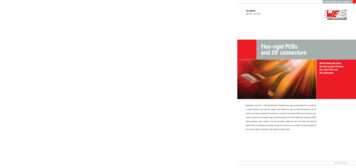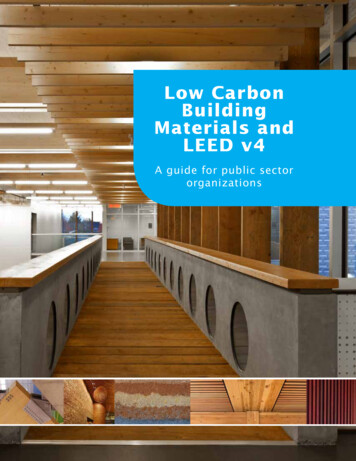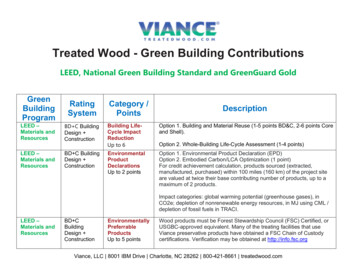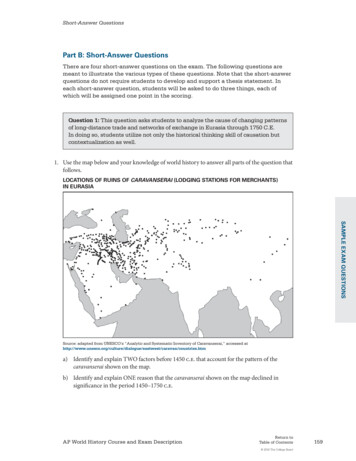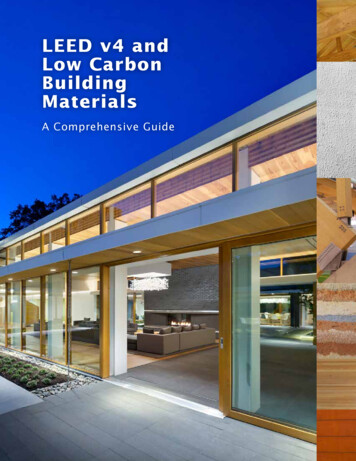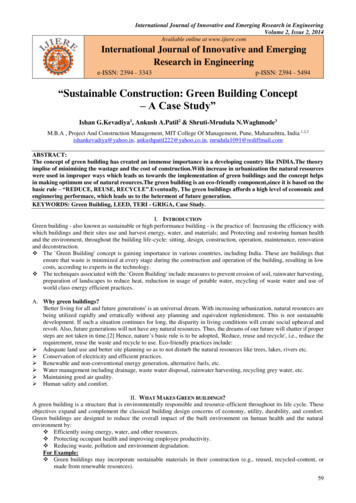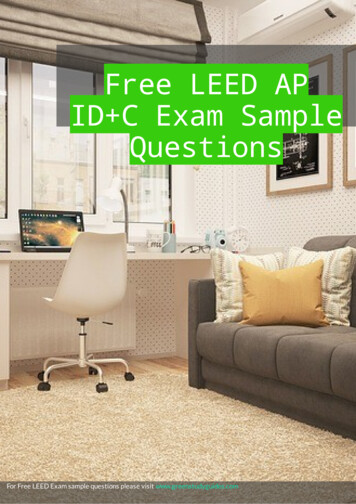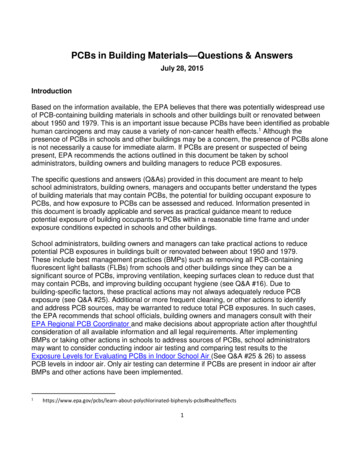
Transcription
PCBs in Building Materials—Questions & AnswersJuly 28, 2015IntroductionBased on the information available, the EPA believes that there was potentially widespread useof PCB-containing building materials in schools and other buildings built or renovated betweenabout 1950 and 1979. This is an important issue because PCBs have been identified as probablehuman carcinogens and may cause a variety of non-cancer health effects.1 Although thepresence of PCBs in schools and other buildings may be a concern, the presence of PCBs aloneis not necessarily a cause for immediate alarm. If PCBs are present or suspected of beingpresent, EPA recommends the actions outlined in this document be taken by schooladministrators, building owners and building managers to reduce PCB exposures.The specific questions and answers (Q&As) provided in this document are meant to helpschool administrators, building owners, managers and occupants better understand the typesof building materials that may contain PCBs, the potential for building occupant exposure toPCBs, and how exposure to PCBs can be assessed and reduced. Information presented inthis document is broadly applicable and serves as practical guidance meant to reducepotential exposure of building occupants to PCBs within a reasonable time frame and underexposure conditions expected in schools and other buildings.School administrators, building owners and managers can take practical actions to reducepotential PCB exposures in buildings built or renovated between about 1950 and 1979.These include best management practices (BMPs) such as removing all PCB-containingfluorescent light ballasts (FLBs) from schools and other buildings since they can be asignificant source of PCBs, improving ventilation, keeping surfaces clean to reduce dust thatmay contain PCBs, and improving building occupant hygiene (see Q&A #16). Due tobuilding-specific factors, these practical actions may not always adequately reduce PCBexposure (see Q&A #25). Additional or more frequent cleaning, or other actions to identifyand address PCB sources, may be warranted to reduce total PCB exposures. In such cases,the EPA recommends that school officials, building owners and managers consult with theirEPA Regional PCB Coordinator and make decisions about appropriate action after thoughtfulconsideration of all available information and all legal requirements. After implementingBMPs or taking other actions in schools to address sources of PCBs, school administratorsmay want to consider conducting indoor air testing and comparing test results to theExposure Levels for Evaluating PCBs in Indoor School Air (See Q&A #25 & 26) to assessPCB levels in indoor air. Only air testing can determine if PCBs are present in indoor air afterBMPs and other actions have been polychlorinated-biphenyls-pcbs#healtheffects1
The Exposure Levels for Evaluating PCBs in Indoor School Air provided in this Q&Adocument are based on potential exposure of school occupants over the course of a typicalschool year and are meant to keep total daily PCB exposure below the EPA life-timereference dose level for PCBs. These levels for indoor school air are not meant to beinterpreted or applied as “bright line” or “not-to-exceed” criteria. Rather, measurements abovethese levels are intended to suggest the need for the further investigation of PCB sources inthe school building and other actions to reduce exposure. If indoor air PCB concentrationspersist above these levels in school buildings, school administrators should work inconsultation with their EPA Regional PCB Coordinator to develop a plan to minimizeexposures, including, as appropriate, plans to remove PCB-containing building materials.Note the Exposure Levels for Evaluating PCBs in Indoor School Air discussed in Section IVof this document were developed specifically for schools and cannot be directly applied toother buildings without adjustment of the underlying exposure assumptions (see Q&A #27,28, 30 and 31).This document is intended to be used as an informal reference and is not intended to be asummary of applicable PCB requirements. This document does not replace nor supplant therequirements of the Toxic Substances Control Act (TSCA) PCB regulations. Please refer tothe regulations at 40 CFR part 761 for specific regulatory and legal requirements. You canalso contact the appropriate EPA Regional PCB Coordinator if you have more questionsconcerning PCBs in building materials.2
I. Potential Sources of PCB Exposure in Schools and Other BuildingsA. OverviewB. Manufactured Sources of PCBs in Schools and Other Buildingso PCBs in Fluorescent Light Ballasts (FLBs)o PCBs in Caulko PCBs in Paint and Coatingso Other Potential Manufactured SourcesC. Secondary Sources of PCBsII. Actions to Reduce PCB Exposure in Schools and Other BuildingsA. Best Management Practices (BMPs)B. PCB Source Removal and RepairIII. Assessment of PCBs in Schools and Other BuildingsA. Air Testing for PCBsB. Interior Building Surfaces Testing for PCBsC. Testing Building Materials for PCBsIV. Exposure Levels for Evaluating PCBs in Indoor School AirV. Research StudiesVI. EPA’s Enforcement Approach for PCB-Containing Building Materials3
I. Potential Sources of PCB Exposure in Schools and Other BuildingsA. Overview1. What are potential sources of PCBs in schools and other buildings?Potential sources of PCBs in schools and other buildings built or renovated between about 1950and 1979 include caulking used around windows, door frames, building joints, masonry columnsand other masonry building materials. PCB-containing caulk may be present inside and on theexterior of the building as well as in surrounding surfaces. PCBs have been used in paints,mastics and other adhesives, fireproofing materials, and in the manufacture of some ceiling tilesand acoustic boards, among other products. PCBs may also be present in high intensitydischarge (HID) lamp ballast capacitors and the capacitors of fluorescent light ballasts (FLBs)manufactured before 1979. The capacitors within the light ballasts in HID and fluorescent lightingfixtures serve to limit the amount of electrical current going to the lamp (e.g., tube or bulb). PCBscan emit into the air during normal use of these fixtures and if the ballast fails or ruptures.Building materials where PCBs were intentionally added during manufacture or application(called manufactured sources or also primary sources, such as the examples above) can lead toPCBs in indoor air. PCBs in the indoor air can then adsorb onto other surfaces and dust, whichbecome secondary sources of PCBs (sources of PCBs where PCBs were not intentionally addedto the material). These secondary sources may, in some cases, contribute to PCB concentrationsin indoor air even after the manufactured sources are removed. PCBs from manufacturedsources such as caulk may also contaminate adjoining materials, such as masonry or wood,through direct contact and create secondary sources.2. How are building occupants exposed to PCBs in schools or other buildings?PCB exposure to building occupants may occur through inhalation of PCBs that have off-gassedinto the air from both manufactured sources and secondary sources. Building occupants may alsobe exposed to PCBs through the ingestion of PCB-containing dust and residues present onbuilding surfaces transferred from hand to mouth. Building occupants may also experience directdermal exposure to PCBs.3. What are additional sources of PCB exposure to the general population?Dietary intake and inhalation are the greatest sources of exposures to PCBs in the generalpopulation, although PCB concentrations in food have decreased. Together, these sources ofPCBs generally result in background exposures that are significantly below the “referencedose” – or the amount of PCB exposure that EPA does not believe will cause harm (see Q&A#25 and #27). Indoor and outdoor air typically contain small amounts of PCBs. Most of thedietary intake comes from consumption of fish/seafood, meat, and dairy products. Somepopulation groups or individuals with high fish/seafood consumption may experience higherdietary intake of PCBs than the general public.4
B. Manufactured Sources of PCBs in School and Other BuildingsPCBs in Fluorescent Light Ballasts (FLBs)4. Why are PCB-containing FLBs a concern?PCBs are contained within the FLB capacitors and in the FLB interior potting material of oldmagnetic T12 lighting fixtures (see Q&A #5). The capacitor regulates the amount of electricitycoming into the lighting fixture and the potting material serves to insulate the FLB and reducethe “humming” noise. Because all PCB-containing FLBs currently in use have exceeded theirdesigned life span, it makes them susceptible to leaking or rupturing at any time which maylead to increased exposures to building occupants. Residues from these sources are difficultand costly to clean up. Additionally, intact PCB-containing FLBs may emit small amounts ofPCBs into the air during normal use of the lighting fixture. For these reasons, EPArecommends all PCB-containing FLBs be removed from lighting fixtures. Note that EPA haslimited data suggesting older HID ballast capacitors may be a source of PCB exposure. EPArecommends that school administrators and building owners consider removing andreplacing HID ballasts that contain PCBs.5. How do I know if my building has PCB-containing FLBs?Any building built or renovated before 1979 (most uses of PCBs were banned in 1979) is likely tohave PCB-containing FLBs if it has not undergone a complete lighting retrofit after 1979 (i.e., alllight fixtures in the building are replaced with those manufactured after 1979). In some cases,PCB-containing FLBs that were manufactured before 1979 were stored and later used in somefluorescent light fixtures installed or repaired after 1979. Thus, some schools and other buildingsbuilt after 1979 that have not undergone a complete lighting retrofit could have PCB-containingFLBs. To determine whether your building has PCB-containing FLBs, conduct a visual inspectionof the FLBs in a representative number school-buildings) of light fixtures (not just the tubes). Examining any available date ofmanufacture information is recommended.The following criteria are provided to help identify FLBs that may contain PCBs: FLBs manufactured before July 1, 1979 may contain PCBs.FLBs manufactured between July 1, 1978 and July 1, 1998 that do not contain PCBs must belabeled “No PCBs” by the manufacturer.If an FLB is not labeled “No PCBs”, it is best to assume it contains PCBs unless it is known tobe manufactured after 1979.FLBs manufactured after 1998 are not required to be labeled but should not contain PCBs.Note that PCBs are contained within magnetic T12 FLB capacitors and in the FLB interiorpotting material. Only the T12 magnetic FLBs (not T8 or T5 FLBs) may contain PCBs. The “T”designates the lamp that goes with the FLB as a “tubular” shape. The number after the “T”represents the lamp diameter in eighths of an inch.5
6. What should I do if my building has PCB-containing FLBs?EPA recommends removing all PCB-containing FLBs from schools and other buildings becausethese FLBs have exceeded their designed life span and are susceptible to leaking or rupturing inthe future. Leaking PCB-containing FLBs left in place are a violation of the PCB regulations andmust be removed. If there is staining or residues on light fixtures and/or on building surfaces thatare attributable to prior PCB releases from the FLBs, the fixtures and surfaces must be cleanedor disposed of in accordance with 40 CFR part 761, subpart D. Consult with your EPA RegionalPCB Coordinator to ensure that all relevant clean-up procedures are followed. Replacing oldlighting systems with new, energy efficient systems will eliminate this potential source of PCBs.For more information on PCBs in FLBs, see ol-buildings. (see also Q&A #17).PCBs in Caulk7. What is known about the use of PCBs in caulk?PCBs were widely used in caulking and elastic sealant materials, particularly between aboutthe 1950s through the 1970s. These materials were primarily used in or around windows, doorframes, stairways, building joints, masonry columns, and other masonry building materials.PCBs were used in these building materials because of their properties as a plasticizer. PCBshave been detected in caulk in buildings, including schools, with concentrations ranging frombelow 50 parts per million (ppm) to greater than 440,000 ppm.8. Why is caulk a potential source of PCB exposure?If caulk contains PCBs, the PCBs may be released into the air through off-gassing. This mayoccur when the caulk is intact and undisturbed or if it is deteriorating. PCBs in the air originatingfrom caulk can then be absorbed into other building materials, creating secondary sources whichcan then re-emit PCBs into the air (see Q&A # 13). PCBs in manufactured materials such ascaulk may also move directly into adjoining materials, particularly porous materials such aswood, concrete, and other types of masonry. PCBs from exterior caulks may also leach intosurrounding building materials and soil from precipitation and deterioration of the caulk, and fromdisturbances during renovations or construction.9. How many schools and other buildings built or renovated between about 1950 and 1979contain PCB-containing caulk?EPA does not have much information on the prevalence of PCB-containing caulk in schools andother buildings. Based on the limited number of test samples gathered from different parts of thecountry, EPA believes that there was potentially widespread use of PCB-containing caulk inschools and other buildings built or renovated between about 1950 and 1979.6
10. Is PCB-containing caulk present in housing structures?In some instances, EPA found PCBs in large scale apartment complex buildings. However, theuse of PCBs in residential building materials is not well documented.PCBs in Paint and Coatings11. Are PCBs present in paint used in schools and other buildings built or renovatedbetween about 1950 and 1979?PCBs may have been intentionally added to some specialty paints and coatings to improve theirperformance for use primarily in industrial and/or military applications (e.g., paints manufacturedto endure thermal stress, vibration or corrosivity) but such specialty paints or coatings couldhave been used in some schools and other buildings built or renovated between about 1950and 1979. PCBs intentionally added to specialty paints and coatings may occur in highconcentrations. Although specialty paints or coatings were not typically used for interior orexterior decorative architectural uses, PCBs have been found in paint on walls in some schoolsand other buildings, so all interior and exterior decorative uses of PCB-containing paint cannotalways be ruled out. PCBs in manufactured materials such as specialty paint may movedirectly into adjoining materials, particularly porous materials such as wood, concrete, andother types of masonry. PCBs, if present in exterior paints, may also leach into surroundingbuilding materials and soil from precipitation and deterioration of the paint, and fromdisturbances during renovations or construction.Other Potential Manufactured Sources12. What are other manufactured sources of PCBs in building materials?Besides caulk, paint and FLBs, other building materials or components may have beenmanufactured with PCBs. For example, window glazing, ceiling tiles, spray-on fireproofing, andfloor finish containing PCBs have been found in some schools and other buildings. These otherpotential sources of PCBs and the extent of their use in schools and other buildings are not wellcharacterized.C. Secondary Sources of PCBs13. What are examples of secondary sources of PCBs?Secondary sources of PCBs are created when PCBs in manufactured sources moveinto other materials in schools and other buildings. Examples of secondary sources ofPCBs include dust, paint, laminates, wood products, masonry, furniture foam, ceilingtiles, floor tiles, and carpet. There are two primary mechanisms for the movement ofPCBs in schools and other buildings. First, PCBs are emitted from manufacturedmaterials into the air inside schools and other buildings. PCBs in the air are thenabsorbed into other building materials, components, furnishings and dust. Second,7
PCBs in manufactured materials such as caulk may move directly into adjoiningmaterials, particularly porous materials such as wood, concrete, and other types ofmasonry. In schools with manufactured PCB sources, many different kinds of buildingmaterials have been found to have measurable levels of PCBs and are potentialsecondary PCB sources.14. What do we know about PCB concentrations on interior building surfaces forschools and other buildings constructed or renovated using PCB-containingbuilding materials?Interior building surfaces (through residues and dust) are a potential source of non-dietaryingestion, dermal and inhalation exposure to PCBs. Available data indicate that when present,PCB concentrations on interior building surfaces can be variable from building to building andfrom room to room within the same building. Indoor dust is composed of multiple types ofmaterials, potentially including deteriorating building materials, outside soils tracked into schoolsand buildings, and various kinds of organic matter. Measured values of PCBs in dust haveranged from less than 1 to 6,800 micrograms (one microgram is equal to one millionth of a gram)of PCBs per gram of dust. EPA recommends that interior building surface concentrations ofPCBs be minimized through appropriate and frequent cleaning (see Q&A #16).15. What do we know about PCB concentrations in the soils surrounding schools andother buildings constructed or renovated using PCB-containing building materials?The soils surrounding schools and other buildings can be contaminated with PCBsoriginating from PCB-containing building materials, particularly from exterior caulks andsealants. In general, although not in all cases, measurements have indicated that higherconcentrations of PCB-contaminated soils are found closest to the schools and otherbuildings.II. Actions to Reduce PCB Exposure in Schools and Other BuildingsA. Best Management Practices (BMPs)16. What are the BMPs to reduce PCB exposures in schools and other buildings?Regardless of whether PCBs are known to be present, EPA recommends that all schools andother buildings built or renovated between about 1950 and 1979 implement the following practicalactions to minimize potential building occupant exposure to PCBs: Remove all PCB-containing fluorescent light ballasts (FLBs). EPA recommends thatnon-leaking PCB FLBs be removed and retrofitted as part of lighting upgrades or as astand-alone project. Leaking PCB FLBs must be removed as required under 40 CFR part761, subpart D. The EPA recommends that an experienced contractor or properly trainedfacilities maintenance staff perform the removal, cleanup, and disposal of PCB-containingFLBs, light fixtures, and building surfaces. Consult with your EPA Regional PCB8
Coordinator to ensure that all relevant cleanup procedures are followed. For the properremoval and disposal of PCB FLBs see: ol-buildings. Conduct the following best management practices listed below on a frequentongoing basis to minimize potential exposures to PCBs: Ensure that ventilation systems are operating properly and are regularly inspected andmaintained according to system manufacturer instructions and guidelines orANSI/ASHRAE/ACCA Standard 180-2012—Standard Practice for Inspection andMaintenance of Commercial Building HVAC Systems. If system cleaning is needed,follow ANSI/ACCA Standard 6 – Restoring the Cleanliness of HVAC Systems (2007). Clean inside schools and other buildings frequently to reduce dust and residue.Use a wet or damp cloth or mop to clean surfaces.Use vacuums with high efficiency particulate air (HEPA) filters.Do not sweep with dry brooms or use dry cloths for dusting.Wash hands with soap and water, particularly before eating.Wash children’s toys.For EPA’s general school cleaning recommendations visit:http://www.epa.gov/iaq/schools/clean maintenance.htmlDue to building-specific factors, these BMPs may not always adequately reduce PCB exposure.In some cases, additional and more frequent cleaning or other actions to identify and addressPCB sources may be warranted.B. PCB Source Removal and Repair17. What recommendations does EPA provide to school administrators or buildingowners on the proper removal and disposal of PCB fluorescent light ballasts (FLBs)?EPA recommends that an experienced contractor or properly trained facilities maintenance staffperform the removal, cleanup and disposal of PCB-containing FLBs. Leaking PCB FLBs must beproperly disposed of pursuant to the PCB regulations at 40 CFR part 761. Staining or residueson light fixtures and/or on building surfaces that are attributable to prior PCB releases from theFLBs must be cleaned (40 CFR section 761.61 or 761.79) or the contaminated building materialsdisposed of in accordance with 40 CFR part 761, subpart D. Consult with your EPA RegionalPCB Coordinator to ensure that all relevant cleanup procedures are followed. EPA’srecommended procedures for the proper removal of PCB FLBs are listed at: oolbuildings.9
18. Should PCB-containing building materials be removed during building repair andrenovation activities?Yes, EPA recommends that PCB-containing caulk and other PCB-containing building materialsbe removed during planned renovations and repairs (when replacing windows, doors, roofs,ventilation, etc.). Prior to removal, EPA recommends PCB testing for caulk and other buildingmaterials that are going to be removed to determine what protections are needed during removaland to determine proper disposal requirements. Where testing confirms the presence of PCBs atregulated levels in building materials, they must be disposed of in accordance with the PCBregulations at 40 CFR part 761, subpart D. In lieu of testing, caulk and other potentially PCBcontaining building materials that are part of building repair and renovation activities may beassumed to contain PCBs at regulated levels and disposed of in accordance with 40 CFR part761, subpart D.19. What special procedures are needed when doing repairs or renovations thatmay disturb PCB-containing building material?To ensure that PCB-containing building material does not contaminate surrounding surfaceswhen it is removed and disposed of, repairs that disturb PCB-containing building material, suchas window removal and replacement, should be conducted by trained workers who use safe workpractices to minimize dust and contain contaminated waste. EPA has developed guidance forminimizing exposures when conducting repairs and renovation activities, including cleaning thework area once the work is completed; and-repair-activitiesActions contractors should take include: Ensure workers are properly trained and are using gloves, eye goggles, skin protectionand approved particulate breathing masks.In dusty work areas, have showers available and separate changing areas so that duston clothing is not brought home.If working with solvents, provide respirators.Use heavy plastic sheeting to cover floors and other fixed surfaces like large appliancesin the work area.Close and seal vents in the work area and turn off forced-air heating and airconditioning systems.Regularly clean the work area using a HEPA vacuum and wet mopping.Properly dispose of personal protective equipment and cleaning material.Building occupants should be notified of the PCB repair and renovation activities and becompletely isolated from the parts of the building undergoing PCB repair and renovation activitiesto prevent exposure to PCBs. Additional steps, including physically isolating the work space withphysical barriers and negatively pressurizing work areas may be necessary .html). If complete isolation of the work spacecannot be assured, school administrators and building owners should temporarily remove10
occupants from the area of the building while the work is underway.For additional guidance on protecting occupants during renovations or other constructionactivities, see ANSI/SMACNA 008-2008: IAQ Guidelines for Occupied Buildings UnderConstruction. The guidelines are available from the Sheet Metal and Air Conditioning ContractorsNational Association, Inc. (SMACNA) at www.smacna.org.20. Can PCB-containing building materials be encapsulated to prevent the release ofPCBs?EPA has looked at the effectiveness of encapsulation (or sealing) techniques to prevent therelease of PCBs. Based on laboratory research by EPA’s Office of Research and Development,encapsulation was found to be most effective for interior surfaces that contain low levels of PCBs(i.e., up to several hundred parts per million). Encapsulation was not found to be effective formore than a short period of time in reducing air emissions from sources that have a high PCBcontent. Depending on the PCB reduction goal, the performance of the encapsulant and theconditions of the building, the upper limit of the PCB concentration for successful encapsulationmay vary. Therefore, post-encapsulation monitoring may be an essential part of theencapsulation process. Building owners should consult EPA’s research on this issue for morespecifics (see sulation may be useful for the reduction of air emissions from secondary sources such ascontaminated building materials under and around PCB-containing caulk or paint that has beenremoved. Because each site will present unique circumstances, please consult your EPARegional PCB Coordinator regarding the application of encapsulation measures on a case-bycase basis. Additional details about EPA’s research may be found at: dingsIII.Assessment of PCBs in Schools and Other BuildingsA. Air Testing for PCBs21. What should a school administrator do if there are concerns about possible exposure toPCBs in school indoor air?As noted in Q&A #16, EPA recommends that all schools and other buildings built or renovatedbetween about 1950 and 1979 implement Best Management Practices (BMPs) to minimizepotential building occupant exposure to PCBs. After implementing BMPs, school administratorsshould consult with their EPA Regional PCB Coordinator to assess if there still may be thepotential for PCB releases in their school and whether to consider testing indoor air for PCBs. Ifair testing is conducted, the test results should be evaluated using the Exposure Levels forEvaluating PCBs in Indoor School Air (see Q&A #25 & 26).Each school is unique, which means that many factors should be considered when decidingwhether and how to test the indoor air at a school. This decision should be made in consultation11
with the EPA Regional PCB Coordinator and the decision makers should thoughtfully consider allavailable information, such as: school-specific conditions (e.g., building age, types of materialsused in construction, layout, maintenance or renovation history), BMPs already implemented toaddress PCB sources (see Q&A #16), and available technical resources, costs, and publicconcerns.While there are accepted analytical methods to measure PCBs in indoor air samples, there is nobroadly accepted sampling protocol for testing PCBs in indoor air. Accordingly, EPA is unable toprovide a generic recommendation on indoor air testing due to the many different school-specificsituations encountered in designing a sampling plan. Development of an air testing plan shouldendeavor to be as representative as circumstances in the school allow and factor in schoolspecific conditions, which EPA believes school administrators are best positioned to identify inconsultation with their EPA Regional PCB Coordinator. Only air testing can determine if PCBsare present in indoor air after BMPs and other actions have been implemented.If school administrators decide to test school indoor air and find that PCB levels exceed theExposure Levels for Evaluating PCBs in Indoor School Air (see Q&A #25), they should consultwith their EPA Regional PCB Coordinator on appropriate next steps, such as the implementationof BMPs and whether manufactured sources (e.g., FLBs, caulk, paint) or secondary sources(e.g., paint, ceiling tiles) of PCBs should be investigated.Furthermore, if PCB indoor air level exceedances persist, school administrators should workwith their EPA Regional PCB Coordinators to develop a plan to minimize exposures (e.g.,continue following the best management practices as indicated in Q&A #16, such as furthercleaning of affected areas and optimizing ventilation) and investigate additional potential sourcesof PCB-containing building materials or expand air testing to identify the extent of the areas withair level exceedances.See also Q&A #25 for additional information on the Exposure Levels for Evaluating PCBs inIndoor School Air.22. Are there air sampling methods for determining the presence of PCBs in indoor airof schools and other buildings?For determining the presence of PCBs in indoor air of schools and other buildings, EPA hastwo approved air sampling methods: Compendium of Methods for the De
manufactured before 1979. The capacitors within the light ballasts in HID and fluorescent lighting fixtures serve to limit the amount of electrical current going to the lamp (e.g., tube or bulb). PCBs can emit into the air during normal us
